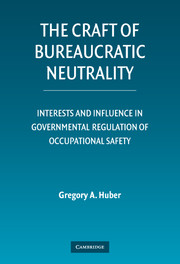 The Craft of Bureaucratic Neutrality
The Craft of Bureaucratic Neutrality 4 - Federal Oversight and State OSH Act Enforcement
Published online by Cambridge University Press: 27 July 2009
Summary
The scope of federal regulation has increased dramatically during the last 100 years. Many of these national efforts involve the states in implementing federal policy. The EPA, for instance, relies heavily on the states to enforce both the Clean Water and Clean Air Acts. For many scholars, this arrangement is one benefit of the American system of federalism, in which power is not concentrated exclusively in the national government (Buchanan 1996). At the same time, other scholars are suspicious of state regulation, noting that states face pressures to reduce the level of regulation in order to attract businesses (Fesler 1949). In this scenario, a “race to the bottom” ensues, and the result is less regulation vis-à-vis unitary federal oversight.
Hybrid federal-state enforcement is perhaps an ideal solution to these trade-offs. States are free to pursue innovative policies or to provide extensive regulation, but the federal government ensures a minimum level of stringency and therefore prevents destructive interstate competition. Shared enforcement is a viable solution to the problem of state competition, however, only if state enforcement is as least as vigorous as its federal alternative. To achieve this end, federal agencies must either avoid delegating power to states that will subvert their statutory mandate or discipline state transgressions.
- Type
- Chapter
- Information
- The Craft of Bureaucratic NeutralityInterests and Influence in Governmental Regulation of Occupational Safety, pp. 172 - 219Publisher: Cambridge University PressPrint publication year: 2007


